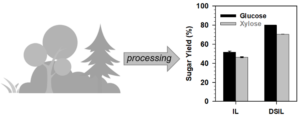APPLICATIONS OF TECHNOLOGY:
- Deconstruction of biomass into biofuels and bioproducts
BENEFITS:
- Improved efficiency of cheaper ionic liquids (ILs) for woody biomass compared to previous methods
- Decreased overall operating expenses (ILs developed from inexpensive reagents)
- Biomass type versatility
- Possible recycling
- Scale-up potential
BACKGROUND:
- ILs have been very attractive components in the essential step of biomass pretreatment. However, economic and technical challenges remain; new methods are required to reduce the cost of ILs without compromising highly efficient pretreatment of woody biomass.
TECHNOLOGY OVERVIEW:
Researchers at Berkeley Lab have developed a unique and economical approach to enhance biomass pretreatment efficacy via double salt ionic liquids (DSILs), which are organic salts containing three or more ions. Particularly, IL-based pretreatments are known to reduce cellulose crystallinity, enhance surface accessibility to biocatalysts, and facilitate lignin removal.
In the pretreatment of challenging woody biomass such as pine at 20% solid loading and identical biomass to IL ratio, the pretreatment efficacy of cholinium lysinate ([Ch][Lys]) measured in terms of sugar release was improved from 49% and 43% to 80% and 70% of glucose and xylose, respectively, when doped with small amounts of 1-ethyl-3-methylimidazolium acetate ([C2mim][OAc]). Also, these ions in combination had a remarkable effect on the lignin structure (less condensed lignin), composition, and content of the lignin that will enable facile conversion of lignin into value-added chemicals. The invention is highly compatible with downstream processes and reduces the amount of ILs required for effective pretreatment.
Ultimately, this technology helps to achieve a high concentration of fermentable sugars while leaving the residual lignin for conversion to valuable chemicals, even from woody biomass.
DEVELOPMENT STAGE: Proven principle
PRINCIPAL INVESTIGATORS:
STATUS: Patent pending.
OPPORTUNITIES: Available for licensing or collaborative research.
